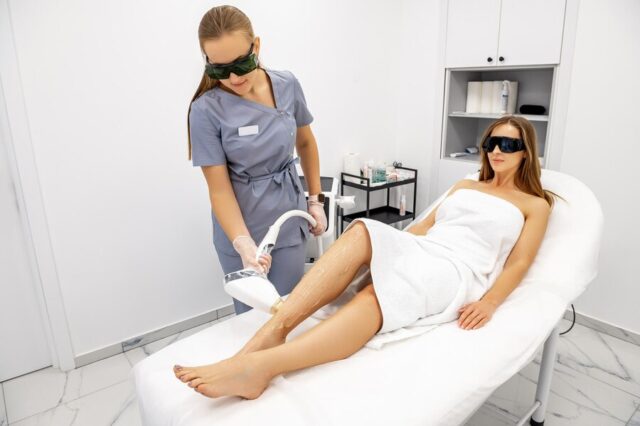The Evolution of Laser Hair Removal Technology

The Evolution of Laser Hair Removal Technology
In the realm of cosmetic enhancements, few technologies have undergone as remarkable an evolution as laser hair removal. From its inception as a groundbreaking solution to unwanted hair, to its current status as a staple in beauty routines worldwide, the journey of laser hair removal technology is nothing short of fascinating. Over the years, advancements in science and technology have propelled this method from its rudimentary beginnings to sophisticated systems capable of delivering precise and long-lasting results.
In this blog series, we’ll delve into the captivating evolution of laser hair removal technology, exploring its milestones, breakthroughs, and the transformative impact it has had on the beauty industry and countless individuals. Join us as we uncover the journey of this revolutionary technology, shaping the way we approach hair removal in the modern age.
Origins of Laser Hair Removal: A Brief History
Laser hair removal, now a ubiquitous part of the beauty industry, has humble beginnings rooted in scientific curiosity and experimentation. The concept of using lasers to remove unwanted hair traces back to the mid-20th century, with early experiments conducted by researchers exploring the potential of lasers in various medical and cosmetic applications. However, it wasn’t until the 1960s that the first laser was developed by Theodore Maiman, marking a significant milestone in the history of laser technology.
The initial attempts at laser hair removal were rudimentary and experimental, lacking the precision and efficacy of modern techniques. In 1964, Dr. Leon Goldman conducted one of the earliest documented experiments using a ruby laser to remove hair, laying the groundwork for further advancements in the field. Throughout the following decades, researchers and scientists continued to refine the technology, experimenting with different types of lasers and refining the techniques used to target hair follicles effectively.
Early Challenges and Milestones
The early days of laser hair removal were fraught with challenges as researchers and scientists grappled with developing a safe and effective method for removing unwanted hair. One of the primary challenges was finding a laser that could effectively target hair follicles without damaging surrounding skin tissue. Early experiments with ruby lasers showed promise but were limited by their inability to target specific hair colors and skin types.
Throughout the 1970s and 1980s, researchers experimented with different types of lasers, including alexandrite and diode lasers, in an attempt to find a more suitable solution for hair removal. These efforts led to significant milestones in the field, with the development of the alexandrite laser in the 1980s representing a breakthrough in laser hair removal technology. The alexandrite laser offered improved precision and efficacy, making it a more viable option for treating a wider range of hair and skin types.
The Science Behind Laser Hair Removal
At the core of laser hair removal lies a sophisticated understanding of the interaction between light energy and the melanin pigment within hair follicles. Melanin, responsible for giving hair its color, serves as the target for laser energy during the hair removal process. When exposed to the intense heat generated by the laser, melanin absorbs the energy, effectively destroying the hair follicle while leaving surrounding skin tissue unharmed.
This principle, known as selective photothermolysis, forms the basis of laser hair removal technology. By carefully selecting the wavelength of light emitted by the laser, practitioners can precisely target melanin within the hair follicle while minimizing the risk of damage to surrounding skin. This selective targeting is what allows laser hair removal to achieve long-lasting results with minimal discomfort and downtime.
Types of Lasers Used in Hair Removal
Over the years, several types of lasers have been developed for use in hair removal, each with its unique characteristics and advantages. The selection of the most suitable laser depends on factors such as skin type, hair color, and treatment goals. Some of the most commonly used lasers in hair removal include:
- Alexandrite Laser: Known for its versatility and effectiveness, the alexandrite laser emits a wavelength of 755 nanometers, making it ideal for targeting melanin within the hair follicle. This laser is particularly effective for treating larger areas of the body, such as the legs and back.
- Diode Laser: Diode lasers emit wavelengths ranging from 800 to 810 nanometers, making them suitable for targeting a wide range of skin types and hair colors. These lasers offer fast treatment times and can effectively target both coarse and fine hair.
- Nd:YAG Laser: Nd:YAG lasers emit longer wavelengths of light (1064 nanometers), allowing them to penetrate deeper into the skin and target melanin within the hair follicle. This makes Nd:YAG lasers an excellent choice for treating darker skin types and for hair removal on areas with thicker skin, such as the back and chest.
- Ruby Laser: Although less commonly used today, ruby lasers were among the first lasers developed for hair removal. Emitting a wavelength of 694 nanometers, ruby lasers are best suited for individuals with fair skin and dark hair.
Advancements in Laser Technology
In recent years, significant advancements in laser technology have revolutionized the field of hair removal, offering patients more effective treatments with fewer side effects and shorter recovery times. One of the most notable advancements is the development of advanced cooling systems, which help to minimize discomfort and protect the skin during laser hair removal treatments.
Early laser hair removal systems often relied on cryogen spray cooling to cool the skin before and after each laser pulse. While effective, these systems were cumbersome and sometimes uncomfortable for patients. Today, modern laser systems incorporate integrated cooling mechanisms, such as sapphire contact cooling or dynamic cooling devices (DCDs), which deliver precise cooling to the skin surface, ensuring patient comfort without compromising treatment efficacy.
Precision and Safety: Key Considerations
Precision and safety are paramount considerations in laser hair removal treatments, as they directly impact treatment outcomes and patient satisfaction. Achieving optimal results while minimizing the risk of adverse effects requires careful attention to detail and adherence to established safety protocols.
One of the key factors influencing the precision and safety of laser hair removal is the selection of the appropriate laser system and treatment parameters. Different types of lasers and wavelengths are better suited for targeting specific hair and skin types, and practitioners must carefully evaluate individual patient characteristics to determine the most suitable treatment approach. Additionally, adjusting parameters such as pulse duration, fluence, and spot size allows practitioners to customize treatments to each patient’s unique needs, ensuring optimal results while minimizing the risk of adverse effects.
Targeting Various Skin Types and Hair Colors
One of the significant advancements in laser hair removal technology is the ability to target a wide range of skin types and hair colors effectively. In the past, laser hair removal was primarily suitable for individuals with fair skin and dark hair, as early laser systems struggled to distinguish between melanin in the hair follicle and melanin in the surrounding skin.
However, advancements in laser technology, such as longer wavelengths and adjustable pulse durations, have made it possible to safely and effectively treat individuals with darker skin tones and lighter hair colors. Nd:YAG lasers, for example, emit longer wavelengths of light that can penetrate deeper into the skin, making them suitable for treating darker skin types while minimizing the risk of damage to surrounding tissues.
Pain Management Techniques
While laser hair removal is generally well-tolerated by most patients, some individuals may experience discomfort or mild pain during treatment, particularly in sensitive areas or with higher fluence levels. To enhance patient comfort and minimize discomfort during laser hair removal procedures, practitioners employ various pain management techniques.
One of the most common pain management techniques is the use of integrated cooling systems, such as sapphire contact cooling or cryogen spray cooling, to cool the skin before, during, and after each laser pulse. These cooling systems help numb the treatment area, minimize discomfort, and protect the skin from potential thermal injury.
Long-Term Effects and Maintenance
One of the primary appeals of laser hair removal is its ability to provide long-lasting results compared to traditional hair removal methods such as shaving, waxing, or depilatory creams. While individual results may vary depending on factors such as hair color, skin type, and treatment adherence, many patients experience significant and enduring hair reduction following a series of laser hair removal treatments.
The long-term effects of laser hair removal stem from the destruction of hair follicles by the laser energy. When targeted during the active growth phase (anagen), the hair follicle absorbs the laser energy, leading to its destruction and subsequent inhibition of hair regrowth. Over time, with each successive treatment session, fewer active hair follicles remain, resulting in progressively smoother and hair-free skin.
Combining Laser Hair Removal with Other Treatments
In recent years, there has been growing interest in combining laser hair removal with other cosmetic treatments to address multiple concerns simultaneously and enhance overall results. Combining laser hair removal with treatments such as skin rejuvenation, acne therapy, or body contouring can offer patients a comprehensive approach to achieving their aesthetic goals.
One common combination is laser hair removal with skin rejuvenation treatments such as fractional laser resurfacing or intense pulsed light (IPL) therapy. By addressing both unwanted hair and skin concerns such as wrinkles, pigmentation, or texture irregularities, patients can achieve smoother, more youthful-looking skin with fewer treatment sessions.
In Conclusion, the journey through the Evolution of Laser Hair Removal Technology has been a remarkable one, showcasing the ingenuity and dedication of scientists, researchers, and practitioners in the pursuit of safer, more effective solutions. As we look ahead, the future holds even more promise for innovative advancements in this transformative field. At American Laser Med Spa, we’re committed to transforming lives by making people feel young, beautiful, and confident, all while building a supportive community. For the ultimate in patient care and the best laser hair removal experience, contact us today at 915-760-5123 or email us at Elpaso@americanlaser-medspa.com.







